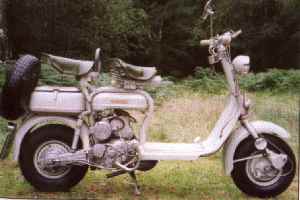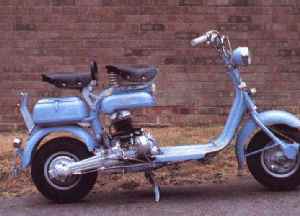As well as the obvious Italy, Lambretta's
have been made around the world, in the next series of pages we cover the
history of all the models produced. Starting with the Italian ones, but
also including all the other models made in other countries such as Spain,
India, Argentina, Brazil, Chile and more.
IT STARTED WITH AN "A"
Model A

The Lambretta A first went on sale in Italy on December
23rd 1947 but Innocenti, one of Italy's leading engineering companies,
had been playing around with the idea of producing a two wheeled vehicle
for some years before the end of the year, with a known prototype existing
since at least 1944. As a cheap form of post war transport, the 'A' Model
had a lot to offer the ordinary person. It was economical (160-180mpg at
a time when petrol was severely rationed), with moderate speed of 45mph.
The engine is a 123cc direct air cooled unit (52*58 bore/stroke), shaft
driven, which has three gears that are foot operated via a rod mechanisms
(the only model to have this). There is very little in the way of suspension,
with only two rubber bushes in the front forks and a solid rear end. The
brakes are quite unusual in that the actual brake shoes are made of cast
iron, and the brake drum is lined with the friction material. During the
year that the 'A' was in production it was available in five different
colours: green, red, beige, blue and grey and approximately 9,000 were
sold
RACING HISTORY
 Innocenti's eagerness to prove to the world that the Lambretta engine was
the most economical and the fastest in the world, for its cc's, lead them
to build many one off's and works racers. This the Racing Model A with
a slightly larger bore and a few tuning modifications is capable of almost
70mph. It was built in 1948 and has many Model B components.
Innocenti's eagerness to prove to the world that the Lambretta engine was
the most economical and the fastest in the world, for its cc's, lead them
to build many one off's and works racers. This the Racing Model A with
a slightly larger bore and a few tuning modifications is capable of almost
70mph. It was built in 1948 and has many Model B components. |
Model B

Staggered by the volume of demand for the 'A' Model, Innocenti
soon realized that the market would demand a more sophisticated machine,
thus the 'B' was born. The 'A' was a good base to start with economy -
simplicity - reliability - but the concept just needed refining. Introduced
in 1948, on face value the 'B' Model appeared to be no more than a cosmetic
face lift of the 'A'. It was much more than this though, with larger 3.50*8
wheels instead of the 'A's 3.00*7, speedo, front & rear suspension,
handlebar gear change, and many more subtle changes. The 'B' was also available
in metallic colours and a huge range of other choices. Innovation came
thick and fast in the early stages in the development of the Lambretta
because Innocenti were not afraid of change. Many of the principles that
they developed some fifty years ago, are now being used by the Japanese
to dominate the two wheeled market today.
Model C
 The Model C first started production in 1950 and ran until
1952. During this period of time, some 150,00 Model C's were produced and
sold mainly in Italy - a staggering increase in production from the 'A'
& 'B' Models. The most notable improvement over the two previous models,
was the frame. The engine is similar in design to the earlier versions,
being 123cc direct air cooled, producing 5bhp , with an MA16 Dell'orto
carburettor and 3 speed gearbox. Top speed was around 50mph, fuel consumption
being between 120-140mpg. Wheels were 4.00*8 and the brakes were now as
we know them today with the friction material on the actual shoe instead
of the drum. Four colours were available, green, brown, sky blue and red.
Again many accessories were available for your 'C' including speedo, horn
cover, spare wheel, floor mats, and added weather protection in the form
of extra bolt on leg shields, plus many other things to personalize your
Lambretta.
The Model C first started production in 1950 and ran until
1952. During this period of time, some 150,00 Model C's were produced and
sold mainly in Italy - a staggering increase in production from the 'A'
& 'B' Models. The most notable improvement over the two previous models,
was the frame. The engine is similar in design to the earlier versions,
being 123cc direct air cooled, producing 5bhp , with an MA16 Dell'orto
carburettor and 3 speed gearbox. Top speed was around 50mph, fuel consumption
being between 120-140mpg. Wheels were 4.00*8 and the brakes were now as
we know them today with the friction material on the actual shoe instead
of the drum. Four colours were available, green, brown, sky blue and red.
Again many accessories were available for your 'C' including speedo, horn
cover, spare wheel, floor mats, and added weather protection in the form
of extra bolt on leg shields, plus many other things to personalize your
Lambretta.
Racing Model C
 Approximately a dozen of these competition C's were as far as known produced.
They were constructed solely for high-speed trials, which explains the
rather large fuel tank and quick release spare wheel. Performance for its
day was quick, and compares with an Innocenti GP200.
Approximately a dozen of these competition C's were as far as known produced.
They were constructed solely for high-speed trials, which explains the
rather large fuel tank and quick release spare wheel. Performance for its
day was quick, and compares with an Innocenti GP200. |
Model D

The Model 'D' started life in December of 1951, when a
125cc version was introduced. The 'D' was basically an update of the earlier
'C' with many improvements being made. A rear suspension damper was now
fitted, a battery to take care of the horn and parking lights, along with
improvements to the engine were all new. Engine output was now up to 6bhp,
with a claimed 52mph top speed. Fuel consumption was in the region of 140mpg,
which along with the cheap prices (£108 in 1956 undercutting Vespa's)
and servicing costs, helped make the 'D' and its sister the plusher LD
very popular. Later models gained twin gear change cables instead of the
earlier single teleflex examples which again helped with the ease of operation
for its owner. A few improvements were made over its production run, and
then in October 1954 a 150cc 'D' was made available. Over 150,000 models
were made by the Italians, with many many more being made outside of Italy
as Innocenti started selling the rights to build Lambrettas in many different
countries including France and Argentina to name a but few. Colours available
for the D were green, grey or beige.
Racing Model D
 Very similar to the competition 'C'. They appear to be modelled on the
later 'D's because of the cable operated rear brake, rear suspension damper
and 150cc engine. The thought is that these machines were a very limited
production, and offered by the Innocenti factory to dealers who managed
to sell the greatest volume of scooters for them. The pillion seat was
standard, and the only colour they were available in was red.
Very similar to the competition 'C'. They appear to be modelled on the
later 'D's because of the cable operated rear brake, rear suspension damper
and 150cc engine. The thought is that these machines were a very limited
production, and offered by the Innocenti factory to dealers who managed
to sell the greatest volume of scooters for them. The pillion seat was
standard, and the only colour they were available in was red. |
Model E & Model F

The Model 'E' (produced between 1953 - 1956), and the
Model 'F' (1955 - 1958) were both very similar in design with the only
noticeable difference being the 'F' had a kick starter. They were both
much lighter than previous models, the frame was made much more simplified,
and the engine modified. Through much research, there is believed to be
around seven different versions of 'E' and 'F' all with slight differences.
The picture above is of what is though to be a 1955 or 1956 (Model F) version,
finished in a rare colour of blue, as it was originally thought these models
were only available in grey or alabaster.
LD (1952 - 1957)
 There were many different versions of the LD starting
with the MK1 and going up to MK IV (not a true mark four version as this
model was made in France to help Innocenti with their supply problems,
due to the worldwide demand for Series 1 Lambretta's). The Ld was available
in both 125cc and 150cc and was by far the most popular model ever produced.
The engine was again similar in design to the earlier models being 3 speed
etc and a top speed of 52mph was quoted in the sales leaflets. The Ld was
really the big brother to the Model 'D' and as such were very similar to
each other, and sold along side one another. Although Italian production
stopped in 1957 with it's new Li range, many different versions were produced
around the world under license from Innocenti, for many years afterwards.
There were many different versions of the LD starting
with the MK1 and going up to MK IV (not a true mark four version as this
model was made in France to help Innocenti with their supply problems,
due to the worldwide demand for Series 1 Lambretta's). The Ld was available
in both 125cc and 150cc and was by far the most popular model ever produced.
The engine was again similar in design to the earlier models being 3 speed
etc and a top speed of 52mph was quoted in the sales leaflets. The Ld was
really the big brother to the Model 'D' and as such were very similar to
each other, and sold along side one another. Although Italian production
stopped in 1957 with it's new Li range, many different versions were produced
around the world under license from Innocenti, for many years afterwards.
OTHER MODELS COVERED
SERIES 1 & 2 / SERIES 3
NEXT
All photo's
with kind permission from Scootering Magazine
For more Info and a complete history see LCGB
These Pages Taken DIRECTLY from
Lambretta Club of Great Britain











